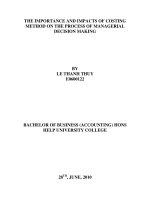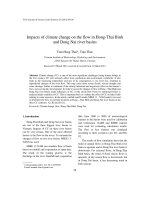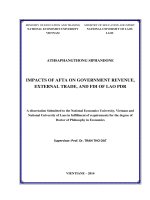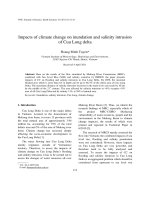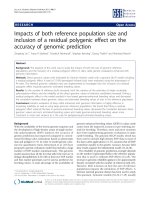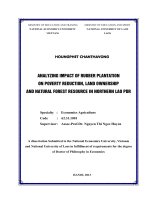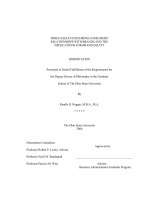Impacts of advertising and sales promotion on brand equity of soft drinks
Bạn đang xem bản rút gọn của tài liệu. Xem và tải ngay bản đầy đủ của tài liệu tại đây (717.42 KB, 15 trang )
JED No.216 April 2013 | 131
Impacts of Advertising and Sales Promotion on
Brand Equity of Soft Drinks
LÊ ĐĂNG LĂNG
Master of Arts, University of Economics and Law
Email:
ABSTRACT
The paper aims to illuminate the relationship between advertising, promotions and
brand equity. First of all, a preliminary research is conducted by means of group
discussions and in-depth interviews to formulate a measurement scale. Then, to
conduct the official research, 339 questionnaires are disseminated to respondents to
collate data. The EFA, Cronbach’s Alpha, and CFA are utilized to test the scale.
Hypotheses are tested by the SEM. Analytical results indicate that the determinants of
brand equity in the soft drinks industry comprise: brand awareness, perceived quality,
brand associations and brand loyalty. Advertising positively affects components of the
brand equity; promotions can enhance the perceived quality; the brand awareness
boosts brand associations; and the perceived quality promotes the brand loyalty.
Keywords: brand equity, soft drinks, advertising, sales promotion, Vietnam
132 | Lê Đăng Lăng | 131 - 145
Impacts of Advertising and Sales Promotion
1. INTRODUCTION
In the context of rapid globalization, brand name building can consolidate
competitive edges of an enterprise (Aaker, 1996). In developed countries, this issue has
been properly attended to and many strong brand names have been developed.
Specifically, according to Interbrand, top-three leading brand names in the world in
2012 comprise Coca-Cola (US$77.8 billion), Apple (US$76.6 billion) and IBM
(US$75.5 billion).
In Vietnam, together with the penetration of multinationals like Rejoice, Tide,
Sunsilk, Omo, Coca-Cola, and so on since the early 1990s, development of a strong
brand name is really a matter of concern, especially after 2000. It is possible to
exemplify some Vietnamese favorite brand names including Không Độ, Number One;
Trung Nguyên, Vinamilk and so on. However, numerous brand names, especially
those of fast-moving consumer goods (FMCG), have not been successfully built.
Moreover, in the FMCG market, soft drinks make up the largest share with the most
dynamic and competitive business climate. Specifically, according to Datamonitor
(2010), the value of soft drinks such as bottled drinking water, bottled coffee, bottled
tea, fruit juice, carbonated beverages, tonics, or the like which have been sold in
Vietnam reached US$786.4 million in 2009 and was predicted to soar to US$1,119.8
million in late 2014. Meanwhile, hot drinks such as coffee and tea which are served hot
reached US$708.4 million in 2009 and were expected to hit US$853.4 million in 2014.
Therefore, in the soft drinks market, albeit branding has been properly attended to,
some enterprises such as Laser, TriO and X2 cannot make their own names.
Numerous theoretical and empirical studies indicate that in order to boost brand
equity, it is necessary to beef up promotion which, if conducted effectively, can help
increase brand equity in customers’ mind (Yoo et al., 2000). Yet in Vietnam, it is not
always true that application of promotional tools can develop a brand name or increase
brand equity. Hence, opting for an appropriate promotional tool is crucial to build
brand equity. Although there have been various studies concerning such issues such as
Aaker (1991), Keller (1993), Yoo et al. (2000), and Ramos and Franco (2005), they are
merely for developed countries with certain durable consumer goods while those for a
developing country like Vietnam are quite rare. Therefore, this paper aims to test the
relationship between brand equity of soft drinks and the two common promotional
JED No.216 April 2013 | 133
tools (i.e. advertising and sales promotion) which are often utilized by Vietnamese soft
drinks manufacturers.
2. REVIEW OF LITERATURES, RESEARCH MODEL, AND HYPOTHESES
a. Literature Review:
Brand name may be a name, a phrase, a sign, a symbol, an icon, or a combination of
these factors given to a type of product or group of products by the company that
produces or sells them so that people will recognize and distinguish them from rival’s
products or services (AMA). Furthermore, some people believe that brand name is the
set of attributes which can provide target customers with value as per their requirement
(Davis, 2002).
In the field of marketing, development of brand name is its focus, which must be
associated with other promotional tools to enhance brand equity. However, brand
equity is produced by various components according to different viewpoints. For
example, as Aaker (1991) states, brand equity is crucial to create distinctive features
and boost competitive edges and is often measured by four main factors, that is, brand
loyalty, brand awareness, perceived quality and brand associations. In the meantime,
Keller (1993) contends that brand equity is customers’ knowledge of the brand name
and is measured by brand awareness and brand impression. In Vietnam, Nguyễn Đình
Thọ and Nguyễn Thị Mai Trang (2011), in their research on the shampoos in HCMC in
2002, introduce three components of brand equity of consumer goods in Vietnam
namely brand awareness, perceived quality, brand desire. Additionally, according to
Kotler (1994), promotion is a part of marketing mix in addition to product, price and
sales; and comprises five principal tools: advertising, public relations, sales promotion,
personal selling and direct marketing. In short, advertising and sales promotion are
main tools of promotion or marketing communication.
b. Research Model and Hypotheses:
In this paper, the model of components of brand equity developed by Aaker (1991,
1996) is employed due to its popularity. Moreover, advertising and sales promotion,
the two primary promotional tools, are used to test their relationship with brand equity
of soft drinks. Although unable to fully represent all promotional activities, these
variables are commonly utilized to measure the building of brands of soft drinks. Thus,
the paper tests impacts of advertising and sales promotion on brand equity of soft
134 | Lê Đăng Lăng | 131 - 145
Impacts of Advertising and Sales Promotion
drinks in Vietnam through brand awareness, brand associations, perceived quality and
brand loyalty. The research model is:
Brand awareness
H1 (+)
Advertising
H2 (+)
H4 (+)
H7 (-)
H5 (+)
Brand associations
H3 (+)
Perceived quality
Sales promotion
H8 (-)
H6 (+)
Brand loyalty
Figure 1: Research model
Various researches on advertising have indicated that advertising could generate
brand equity. Specifically, the amount of investments in advertising can positively
affect brand equity and its components such as brand awareness, brand associations
and perceived quality (Yoo et al., 2000; Ramos and Franco, 2005; Amaretta and
Hendriana, 2011). In addition, advertising also has positive impacts on the brand
loyalty because it can boost brand associations and attitude toward a brand (Yoo et al.,
2000). Simultaneously a greater awareness of brand can increase brand associations,
and a higher perceived quality can improve brand loyalty. Accordingly, hypotheses can
be stated as follows:
H1: The high investment in advertising has positive effects on the brand awareness
(+).
H2: The high investment in advertising has positive effects on the brand
associations (+).
H3: The high investment in advertising has positive effects on the perceived quality
(+).
JED No.216 April 2013 | 135
H4: The high investment in advertising has positive effects on the brand loyalty (+).
H5: The acute brand awareness has positive effects on brand associations (+).
H6: The high perceived quality has positive effects on brand loyalty (+).
Additionally, according to Aaker (1991), albeit sales promotion can increase the
sales within the short term, it cannot have significant effects on the development of
brand equity and even can produce opposite effects. Regular promotion can lead to
impression of an unstable quality of goods in public perception (Yoo et al., 2000). The
fact that consumers cannot predict the price precisely due to the disparity between the
expected price and the quoted one may sharply impinge on the perceived quality.
Furthermore, sales promotion does not last long enough to be able to generate a better
awareness of brand. Seemingly, sales promotion is not related to brand loyalty even
though it increases the shift to a new brand for the time being (Yoo et al., 2000; Ramos
and Franco, 2005). Once a promotion is over and economic benefits no longer exist,
customers will lose their interest in a certain brand. Therefore, the hypotheses 7 and 8
are stated as follows:
H7: The high frequency of sales promotion will decrease brand associations (-).
H8: The high frequency of sales promotion will decrease perceived quality of brand
(-).
3. RESEARCH METHOD AND MEASUREMENT SCALE
a. Methodology:
Both qualitative and quantitative methods are utilized in the research. In the
preliminary research, based on existing measurement scales developed by previous
academic researchers, the research scale was adjusted via discussion in groups of eight
in April 2012. In-depth interviews were then conducted on the basis of ready-made
questionnaires (n=100) to test the scale. Furthermore, scales are also tested by
Cronbach’s Alpha, exploratory factor analysis (EFA), principal component analysis
(PCA) and Varimax rotation. The preliminary research was conducted in May 2012.
Given results from the preliminary research, the author design the questionnaire for
the actual research which was conducted by in-depth interviews with 339 respondents
on June 2012. Its measurement scales were tested by EFA using principal axis
factoring (PAF) with Promax oblique rotation, Cronbach’s Alpha and confirmatory
factor analysis (CFA) (Amos 20).
136 | Lê Đăng Lăng | 131 - 145
Impacts of Advertising and Sales Promotion
Eventually, the structural equation model (SEM), a comprehensive statistical model
which combines multivariable regression and factor analysis and is frequently used to
test impacts of an independent quantitative variables on a dependent quantitative one,
is employed to test the research model and hypotheses. Using PAF with Promax
oblique rotation reflects a more precise data structure than using PCA with Varimax
rotation (GErbing and Anderson, 1988). Hence, it is better to employ PAF to evaluate
the research scale. PCA with Varimax rotation is merely used to extract more variances
from variables. The research subjects are consumers of soft drinks aging from 18 to 25.
Majority of them are students of universities in HCMC and are randomly selected. In
the questionnaire, the Seven-point Likert scale is employed with one as “absolutely
disagree” and seven as “absolutely agree”. Date are filtered and then processed by
SPSS 20.
b. Measurement Scale:
This paper utilizes existing measurement scales of previous academic research and
then adjusts them to fit the case of Vietnam. As was stated above, the research employs
six constructs, that is: investments in advertising (with seven observed variables and
signed as AD); sales promotion (three variables, DL); brand awareness (six variables,
BA); brand associations (six variables, AA); perceived quality (five variables, PQ);
brand loyalty (fives variables, BL); and overall brand equity (four variables, OBE).
4. FINDINGS AND DISCUSSION
a. Findings:
The measurement scales of advertising and sales promotion are tested by EFA using
PAF with Promax oblique rotation on the condition that the factor loading coefficients
of variables must be larger than 0.5 (Hair et al., 2006) and the difference between
loadings must be larger than 0.3 (Jabnoun and Al-Tamimi, 2003). The results are
presented in Table 1.
JED No.216 April 2013 | 137
Table 1: EFA Results Using PAF with Promax for Variables of Advertising and
Sales Promotion
Extracted factors
Codes
Advertising
(1)
Sales promotion
(2)
Interpretation of variables
AD2
0.872
I am very fond of ads for product X.
AD3
0.857
I highly appreciate ads for X.
AD1
0.824
I think ads for X are good.
AD6
0.506
Advertising campaigns for X is very regular.
DL2
0.933
Price promotion for X is conducted with too high
frequency.
DL3
0.792
Price promotion for X is overemphasized.
DL1
0.755
X is regularly discounted.
With KMO = 0.764 > 0.5, the factor analysis is appropriate; and the Barlett test
with Sig.= 0.000 < 0.5 is statistically significant, and thus observed variables are
overall correlated (Trọng and Ngọc, 2008). Given Eigenvalue = 2.057 < 1 and the
variance equaling 65.144% > 50%, the two factors are extracted as follows:
- Factor 1 includes items AD2, AD3, AD1 and AD6 which are the components of
the variable “advertising”.
- Factor 2 comprises items DL2, DL3 and DL1 which are the components of the
variable “sales promotion”
As the Cronbach’s Alpha coefficient indicates, the reliability of extracted factors is
larger than 0.6 and the item-total correlation coefficient larger than 0.3; and thus they
are acceptable (Nunnally and Burnstein, 1994). Unitarity, convergent validity and
discriminant validity of scales are tested by CFA. CFA results, after adjusted on the
basis of relationships having the modification indices (MI) larger than 4, show that the
comparative fit index (CFI), the Tucker-Lewis index (TLI), and the goodness of fit
index (GFI) are larger than 0.9, Chi-square/df equaling 2.7 (<3) and the root mean
square error of approximation (RMSEA) equaling 0.71 (<0.8); and thus they are
appropriate to market data (Nguyễn Đình Thọ and Nguyễn Thị Mai Trang, 2008), and
variables attain their unitarity (Steenkamp & Van Trijp, 1991). Standardized regression
138 | Lê Đăng Lăng | 131 - 145
Impacts of Advertising and Sales Promotion
weights of scales, when tested, are larger than 0.5 at the statistical significance level
smaller than 0.05 (Table 2), so scales achieve convergent validity (Gerbing and
Anderson, 1988). Additionally, the correlation coefficients of scales are smaller than
0.9 (r = 0.149), discriminant validity is assured (Hair et al., 2006).
Table 2: CFA Weights for Advertising and Sales Promotion
Non-standardized
Codes
Estimate
S.E.
C.R.
Standardized
P
Estimate
AD6
<---
Advertising
1.000
0.521
AD3
<---
Advertising
1.441
0.147
9.820
***
0.855
AD2
<---
Advertising
1.582
0.160
9.914
***
0.882
AD1
<---
Advertising
10.364
0.143
9.566
***
0.802
DL3
<---
Sales promotion
1.000
DL2
<---
Sales promotion
1.059
0.067
15.863
***
0.937
DL1
<---
Sales promotion
0.945
0.064
14.845
***
0.772
0.774
b. Testing Measurement Scales of Components of Brand Equity:
Conducting EFA for the scales of components of brand equity using PAF with
Promax rotation generates results in Table 3. With KMO = 0.842 > 0.5 and the Bartlett
Sig. = 0.000 < 0.05, Eigenvalue = 1.084 > 1 and the variance = 63.29% > 50%, they
are acceptable (Gerbing and Anderson, 1988), and four extracted factors are:
Factor 1 comprises items BL1, BL2, BL3, and BL4; and is named “brand loyalty.”
Factor 2 comprises items AA1, BA4, BA5 and BA6; and is named “brand
associations.”
Factor 3 comprises items PQ1, PQ2, PQ4 and PQ5; and is named “perceived
quality.”
Factor 4 comprises items BA1, BA2 and BA3; and is named “brand awareness.”
JED No.216 April 2013 | 139
Table 3: Factor Extraction Matrix for Components of Brand Equity
Extracted factors
Codes
Brand
loyalty
(1)
Brand
Perceived
Brand
associations quality awareness
(2)[*]
(3)
Interpretation of variables
(4)
BL3
0.908
I will not buy any products of the same
type if X is available on shelves.
BL4
0.760
I just seek to buy X but not anything of
the same type.
BL2
0.754
X is my first choice.
BL1
0.634
I think I am loyal to X.
BA6
0.837
Comprehensively, it is easy for me to
visualize X.
BA5
0.811
I can quickly recall and recognize X’s
logo.
BA4
0.749
X’s attributes come to my mind
quickly.
AA1
0.633
X’s distinctive features come to my
mind quickly.
PQ4
0.843
X is reliable.
PQ1
0.796
X’s quality is high.
PQ5
0.705
X’s quality is high for sure.
PQ2
0.689
There is possibility that X’s quality is
exorbitant.
BA2
0.896
I can easily realize X among other soft
drinks.
BA3
0.798
I can easily distinguish X from other
soft drinks.
BA1
0.688
I have knowledge of X’s brand name.
140 | Lê Đăng Lăng | 131 - 145
Impacts of Advertising and Sales Promotion
NB: [*] This construct is a little different from the initial one due to the fact that brand awareness
and brand associations are construed identically. It is also the reason why some researchers in the
world group these two constructs together.
The reliability test indicates that the Cronbach’s Alpha of extracted factors is larger
than 0.6 and the item-total correlation larger than 0.3; and they they are plausible
(Nunnally and Burnstein, 1994). Next, the author conducts CFA to test the unitarity,
convergent validity, and discriminant validity of scales. Accordingly, CFA results after
adjusted produce CFI, TLI and GFI larger than 0.9, Chi-square/df equaling 2.738 (<3)
and RMSEA equaling 0.72 (<0.8); and thus they are congruent with market data, and
the set of observed variables is considered to be unidirectional (Steenkamp and Van
Trijp, 1991).
Due to the fact that the regression weights of scales are larger than 0.5 at the
statistical signicance of 0.05 at most (Table 4), measurement scales attain the
convergent validity (Gerbing and Anderson, 1988). Additionally, the correlation
coefficients are different from zero (r < 0.9), the scale achieves discriminant validity
(Hair et al., 2006).
Table 4: CFA Weights for Components of Brand Equity
Unstandardized
Codes
Estimate
S.E.
C.R.
Standardized
P
Estimate
BL4
<---
Brand loyalty
1.000
.577
BL3
<---
Brand loyalty
1.242
0.088
14.158
***
0.681
BL2
<---
Brand loyalty
1.356
0.131
10.327
***
0.826
BL1
<---
Brand loyalty
1.372
0.133
10.312
***
0.822
AA1
<---
Brand associations
1.000
BA6
<---
Brand associations
1.157
0.087
13.315
***
0.813
BA5
<---
Brand associations
1.104
0.086
12.797
***
0.775
BA4
<---
Brand associations
1.056
0.080
13.214
***
0.805
PQ5
<---
Perceived quality
1.000
PQ4
<---
Perceived quality
0.979
0.701
0.755
0.073
13.379
***
0.762
JED No.216 April 2013 | 141
PQ2
<---
Perceived quality
0.951
0.069
13.736
***
0.761
PQ1
<---
Perceived quality
1.044
0.075
13.988
***
0.774
BA3
<---
Brand awareness
1.000
BA2
<---
Brand awareness
1.043
0.054
19.270
***
0.880
BA1
<---
Brand awareness
0.849
0.059
14.339
***
0.695
0.884
c. Hypotheses Test:
The SEM is used to test the model and hypotheses (AMOS 20). The initial model is
not congruent with the market data due to Chi-square/df = 3.409 > 3, CFI = 0.886 and
TLI = 0.868 < 0.9; RMSEA = 0.084 > 0.08. After adjusting the model by means of
adjusting relationships that have the MI larger than four, the new model is considered
to be congruent with the market data (Figure 2) due to Chi-square/df = 2.8 < 3; CFI =
0.915 > 0.9; TLI = 0.901 > 0.9; RMSEA = 0.073 < 0.08.
Brand awareness
Advertising
Sales promotion
Brand associations
Perceived quality
Brand loyalty
Figure 2: SEM testing results
The testing results on the weights of relationships between scales are presented in
Table 5. Such weights do not change much or distort the nature of correlation of scales
in the initial model. Accordingly, it is possible to arrive at conclusions presented in
Table 5.
142 | Lê Đăng Lăng | 131 - 145
Impacts of Advertising and Sales Promotion
Table 5: SEM Testing Results
Unstandardized
Estimate
S.E.
C.R.
Standardized
P
Estimate
Perceived quality
<--- Sales promotion
0.200
0.050 3.979
***
0.221
Brand awareness
<---
Advertising
0.551
0.102 5.427
***
0.385
Perceived quality
<---
Advertising
0.700
0.107 6.554
***
0.487
<---
Advertising
0.376
0.080 4.707
***
0.296
<---
Advertising
0.227
0.105 2.150
0.032
0.140
Brand associations <---
Advertising
-0.045
0.040 -1.120
0.263
-0.056
0.461
0.058 7.955
***
0.520
0.700
0.086 8.172
***
0.622
Brand associations
Brand loyalty
Brand associations <--- Brand awareness
Brand loyalty
<--- Perceived quality
- H1 is accepted (p < 0.05), and thus high investment in advertising has positive
effects on the brand awareness (+).
- H2 is accepted (p < 0.05), and thus high investment in advertising has positive
effects on the brand associations (+).
- H3 is accepted (p < 0.05), and thus high investment in advertising has positive
effects on the perceived quality (+).
- H4 is accepted (p = 0.032 < 0.05), and thus high investment in advertising has
positive effects on the brand loyalty (+).
Apparently, advertising has positive effects on components of brand equity; in other
words, it can enhance brand equity. Also, the standardized regression weights indicate
advertising has the greatest impacts on perceived quality (0.487), followed by brand
awareness (0.385), brand associations (0.296), and brand loyalty (0.140).
Table 5 also shows that H5 is acceptable (p < 0.05); and thus better awareness of
brand will improve brand associations (0.520). H6 is also accepted (p < 0.05) and thus
the high perceived quality will boost brand loyalty (0.622). Furthermore, sales
JED No.216 April 2013 | 143
promotion has positive impacts on perceived quality with the standardized impact
weight of 0.221 and the statistical significance being smaller than 0.05; and thus H8 is
rejected. The relationship between sales promotion and brand associations is not
statistically significant due to p = 0.263 > 0.05; and thus it is impossible to draw any
conclusion in accordance with H7.
Moreover, the R2 coefficient shows that advertising can explain 14.8% of changes
in brand awareness and 49.8% of changes in brand loyalty; and simultaneously
advertising and sales promotion can explain 46.9% of changes in brand associations
and 32.4% of changes in perceived quality.
5. DISCUSSION
a. Theoretical Contributions:
The research proves that brand equity of soft drinks made in Vietnam is measured
by brand awareness, brand associations, perceived quality and brand loyalty; and that
advertising has positive impacts on components of brand equity. Such findings confirm
previous results by Aaker (1991), Yoo et al. (2000), Ramos and Franco (2005), etc.
concerning components of brand equity and impacts of advertising on them both in the
field of durable consumer goods and in soft drinks industry of a newly-emerging
market like Vietnam.
In addition, the research also extends some significant additions, that is: (1) better
awareness of brand can enhance brand associations, and (2) higher perceived quality
can increase brand loyalty. Such findings illuminate the close relationship between
components of brand equity and explain why well-known brand names are often
considered to be more reliable than others. Once a brand is acutely aware, the brand
loyalty will definitely be high.
Additionally, the research also discovers disparities to previous findings but specific
to soft-drink manufacturers in Vietnam; that is, sales promotion can enhance the
perceived quality of a brand. There are two reasons for this difference: (1) the paper
focuses on soft drinks of FMCG industry which is extremely different from durable
good industry; and (2) characteristics of Vietnamese market are different from those of
the US or Spanish ones.
b. Implications:
144 | Lê Đăng Lăng | 131 - 145
Impacts of Advertising and Sales Promotion
The research’s findings are significant to beverage manufacturers in general and
soft-drink manufacturers in particular. In essence, building a brand name is to develop
brand equity, so it is advised that business administrators and marketers identify
components of brand equity in order to develop more effective strategies and solutions.
Furthermore, determination of influential factors is also significant to development
of brand equity. The paper implies that advertising can improve components of brand
equity, that sales promotion can enhance the perceived quality, that brand awareness
boosts brand associations, and that perceived quality promotes brand loyalty. Such
findings can be used to orient the development of marketing communication in order to
build a strong brand name and reduce costs.
Moreover, soft drinks can represent FMCG sector, thus related manufacturers can
apply the findings to branding. Last but not least, measurement scales of advertising,
sales promotion and components of brand equity, which have been tested, are a
significant source of data for market researchers in Vietnam to design questionnaires.
Yet, marketing administrators should be careful when employing business theories in
general and marketing ones in particular due to the fact that different markets and
different products possess different characteristics.
c. Limitations and Orientations for Further Research:
Like many other studies, limitations are inevitable. Firstly, the data is just collated in
HCMC. Secondly, the study only investigates impacts of advertising and sales
promotion, yet there are many different modes of promotion employed by various
companies in practice. Eventually, every mode of advertising or promotion is often
associated with various tools, and the industry of soft drinks is also split into subindustries of carbonated beverage, fruit juice, etc. Hence, in the upcoming years, it is
necessary to test impacts of other types of promotion such as public relations or TV
sponsorship, etc. on components of brand equity. At the same time, the data should be
collated nationwide from different sub-industries of soft drinks
References
Aaker, D.A. (1991), Managing Brand Equity, Free Press, New York.
Aaker, D.A. (1996), Building Strong Brands, Free Press, New York.
JED No.216 April 2013 | 145
Amaretta, M. & E. Hendriana (2011), “The Effect of Marketing Communications and Price
Promotion to Brand Equity”, Proceedings of the 2nd International Research Symposium in
Service Management in Yogyakarta, Indonesia.
Datamonitor (2010), Hot Drinks & Soft Drinks Market in Vietnam to 2014, Ref. Code: DBCM7358/
DBCM8049.
Gerbing, D.W. & J.C. Anderson (1988), “An Update Paradigm for Scale Development
Incorporating Unidimensionality and Its Assessments”, Journal of Marketing Research,
Vol.25(2), pp.186-192.
Hair, J.F.; B. Black; B. Babin; R.E. Anderson & R.L. Tatham (2005), Multivariate Data Analysis,
6th Ed., Prentice Hall, New Jersey.
Hoàng Trọng & Chu Nguyễn Mộng Ngọc (2008), Phân tích dữ liệu nghiên cứu với SPSS, Hồng
Đức Publisher, HCMC.
Keller, K.L. (1993), “Conceptualizing, Measuring and Managing Customer-Based Brand Equity”,
Journal of Marketing, Vol.1, pp.1-22.
Keller, K.L. (1998), Strategic Brand Management, Prentice Hall, New Jersey.
Kotler, P. & K.L. Keller (2009), Marketing Management, Prentice Hall, New Jersey.
Kotler, P. (1994), Marketing Management, Prentice Hall, New Jersey.
Nguyễn Đình Thọ & Nguyễn Thị Mai Trang (2011), Nghiên cứu khoa học Marketing: Ứng dụng
mô hình cấu trúc tuyến tính SEM, Lao động Publisher, HCMC.
Nguyễn Đình Thọ (2011), Phương pháp nghiên cứu khoa học trong kinh doanh: Thiết kế và thực
hiện, Lao động – Xã hội Publisher, HCMC.
Villarejo-Ramos, A.F & M.J. Sánchez-Franco (2005), “The Impact of Marketing Communication
and Price Promotion on Brand Equity”, Journal of Brand Management, Henry Stewart
Publications, Vol.12(6), pp.431-444.
Yoo, B.; N. Donthu & S. Lee (2000), “An Examination of Selected Marketing Mix Elements and
Brand Equity”, Journal of the Academy of Marketing Science, Vol.28(2), pp.195-211.


